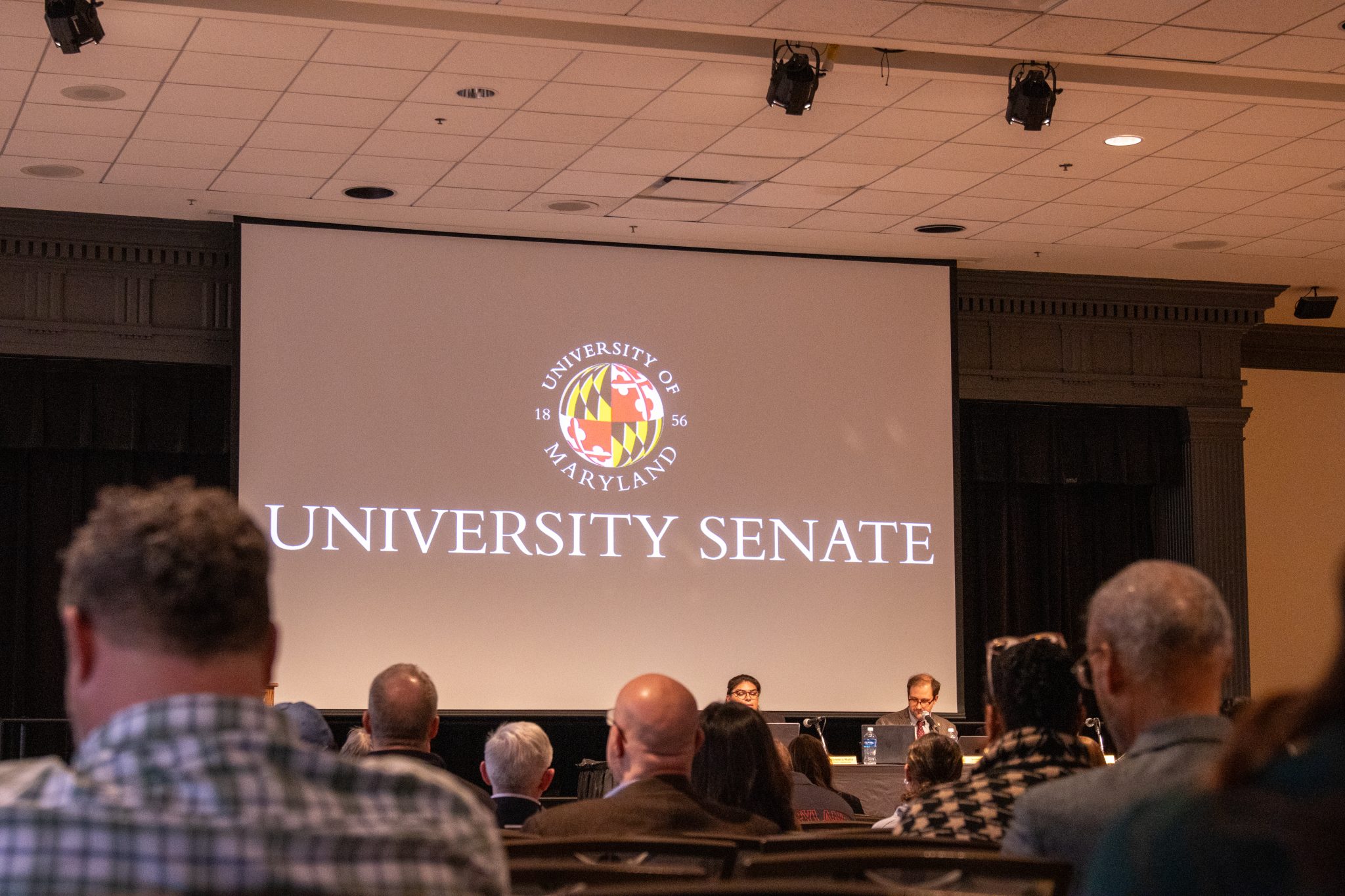The University Senate is one of the largest governing bodies at the University of Maryland with nearly 240 members, including peer-elected students, faculty and staff.
The senate aims to review proposals that reflect this university’s core values and regularly review existing policies, according to the senate’s website. The policies span topics such as university finances to social climate, the website read.
“The senate allows a place for all the concerns of the university to come together,” senate chair Jordan Sly said. “Through the function of shared governance, everyone’s voices can be heard in one way or another.”
The Diamondback spoke with three senators to understand the history of the body as well as its structure and processes.
Senate structure
The senate first assembled in 1919, but was not officially recognized until 1955, according to university archives.
In the 1970s, the senate expanded to include undergraduate students, graduate students and staff.
As of March 2025, the senate has 239 members, consisting of:
- 153 faculty
- 25 staff
- 10 graduate students
- 29 undergraduate students
- 15 deans
- Seven single-member representatives
For most groups, senate seats are allocated based on the size of each represented body. Graduate students are represented by 10 at-large seats, with at most two senators from the same college, while university deans hold their seats by default.
[UMD president Darryll Pines responds to Trump’s executive orders in biannual address]
Faculty and undergraduate student seats are further distributed between the university’s respective colleges and schools as follows:
- Tenured and tenure track faculty have one seat for every 15 eligible faculty members.
- Professional track faculty get one seat for every 30 eligible faculty members.
- Undergraduate students have one seat for every 1,000 undergraduates.
- Staff get one seat for every 200 faculty members in the exempt staff from colleges, exempt staff from divisions, non-exempt staff from colleges and non-exempt staff from divisions categories.
Election process
Senate elections take place annually, typically from January through March, according to the its election page.
People interested in running for a seat can submit their name with a statement explaining why they are qualified for the position to the senate’s website for review.
If approved, the candidates’ names are added to an electronic ballot that is sent out to everyone within their respective constituency.
Faculty and staff senators can serve on the senate for three years, while student and single-member representatives serve for one year. Student and single-member representative seats can also be renewed for three consecutive years, according to the senate website.
Conell Brandner, an undergraduate student senator representing the architecture, planning and preservation school, said he ran for his school’s senate seat because he wanted to become more involved with campus activities as a commuter from Calvert County.
“I feel a lot more connected to the university [now],” the senior architecture major said. “[I feel] more than just a student and just being within the system.”
Senate committees and meetings
The entire senate meets about once a month, normally alternating between Wednesdays and Thursdays from 3:15 to 5 p.m. A majority of meetings are held on Zoom, except for when university president Darryll Pines presents deliver his State of the Campus address in Stamp Student Union’s Colony Ballroom.
Meetings are also open to the public.
There are 10 standing and three active elected committees in the senate.
Standing committees consist of senators and volunteers who serve one to two-year terms. Senate leaders assign committee members proposals to evaluate and revise based on their specialized area of focus.
This university’s standing committees include the equity, diversity and inclusion committee and the student conduct committee.
“Having these committees in an organizational process to refer different matters to, as with any governing body, helps to concentrate the expertise of folks,” M Pease, a counseling psychology doctoral student and at-large senator who represents graduate student constituencies, said.
[UMD launches resource hub to help laid-off federal workers]
Specific dates, times and locations for committee meetings can be found on the senate website’s events calendar.
The senate also has three active elected committees — the executive committee, the committee on committees and the nominations committee. These committees, whose members are elected by other senators, primarily oversee senate operations.
The Senate Executive Committee is made up of the senate chair, chair-elect and 13 additional voting senators. This university’s president, senior vice president and provost are also non-voting members of the committee.
The executive committee sets meeting agendas, decides which committee should review a specific proposal and handles the implementation of approved policies according to the senate’s website.
Sly, the head of the executive committee, said his job is to facilitate senate meetings to ensure they are run fair and smoothly.
The legislative path
Any campus community member can submit a proposal to the senate, according to its website.
After it is submitted, the proposal goes through a thorough legislative process before it is approved and becomes official policy.
“Because we are careful and deliberative in our processes … it can take a long time,” Sly said. “But that doesn’t mean nothing’s happening. There’s a lot going on behind the scenes.”
First, senate leaders review the proposal to ensure it falls under the senate’s sphere of influence and contains enough detail for discussion.
The executive committee then sends the proposal to a specific standing committee or forms a temporary special committee or task force for further review.
After discussion, the respective committee sends the revised proposal back to the executive committee, whose members decide if it is ready to appear on the senate floor for consideration.
When a proposal is sent to the senate floor, its championing committee, task force or special order gives a presentation outlining its recommendations. Then, senators vote to either reject or approve it. A majority vote is required to pass a piece of legislation.
If approved, it is sent to Pines for final assessment, since he maintains the power to modify, pass or reject any proposal, according to the senate website.
In some cases, a proposal may be sent to the university system Board of Regents for further consideration.
At any point during the senate’s legislative process, a proposal can be sent back to its reviewing committee for more work and discussion before advancing onto the next step.
“Like any sort of large institutional body … [the senate] certainly has its flaws and has its limitations,” Pease said. “At the same time, I think I’m grateful for the opportunities and connections that I was able to build through my engagement.”



